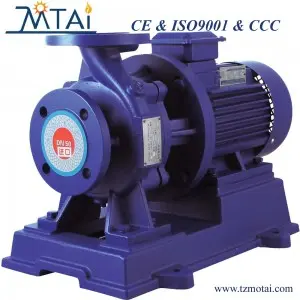Centrifugal pumps are a commonly used power device used to transport liquids from low-pressure areas to high-pressure areas. They are often used in water supply, drainage, irrigation, industrial processes and other applications. Its working principle and structure are as follows:
Working principle: The centrifugal pump uses the centrifugal force generated by the rotation of the impeller to suck the liquid from the inlet of the pump, and push the liquid to the outlet of the pump through the pump casing and outlet pipe, thereby realizing the transportation of liquid. When the motor drives the pump shaft to rotate, the impeller also rotates. The liquid is brought into the gap between the blades under the action of the impeller, and then is pushed from the outlet of the blades to the outlet pipe under the action of centrifugal force, thus forming a continuous fluid flow.
Structure: Centrifugal pumps usually consist of the following main parts:
Pump casing (or pump body): The pump casing is the outer shell of the centrifugal pump, usually made of cast iron, stainless steel, alloy steel and other materials. Its main function is to accommodate and support other pump components, and is formed by connecting with other components. Pump flow path.
Impeller (or blade): The impeller is one of the most important components of a centrifugal pump and is usually made of cast iron, stainless steel, copper alloy and other materials. The impeller generates centrifugal force through rotation, sucking the liquid from the inlet of the pump and pushing it to the outlet, thereby realizing the delivery of liquid.
Pump shaft: The pump shaft is the component that connects the motor and the impeller. It is usually made of high-strength alloy steel or stainless steel. Its main function is to transmit the rotation of the motor to the impeller and is responsible for bearing the axial and radial loads of the pump.
Guide vane (or flow guide): The guide vane is located between the impeller and the pump casing. It is usually made of steel plate, cast iron and other materials. Its main function is to guide the liquid to flow from the outlet of the impeller to the outlet of the pump casing. By adjusting the guide vane angle to control the flow and head of the pump.
Shaft seal: The shaft seal is a component in a centrifugal pump used to prevent the liquid in the pump from leaking out of the pump. It usually consists of a sealing ring, sealing surface, packing, etc. The shaft seal forms a seal between the pump shaft and the pump casing to prevent liquid leakage and also prevents external substances from entering the pump.
Bearing: The bearing is the component that supports the pump shaft of the centrifugal pump. It is usually located between the pump casing and the pump shaft. It bears the axial and radial loads of the pump shaft and ensures the stable operation of the pump shaft. Common bearing types include rolling bearings and plain bearings, the selection and lubrication of which will vary depending on the specific pump design and operating conditions.
Pump base (or base): The pump base is the support structure of a centrifugal pump, usually made of steel. It is used to support the pump casing, impeller and pump shaft, and is fixedly connected to the ground or other foundations to ensure the stable operation of the pump.
Inlet and outlet pipelines: Inlet and outlet pipelines are used to guide liquids into and out of centrifugal pumps. They are usually composed of pipes, flanges and connectors. Their design and installation need to consider factors such as liquid flow, pressure and pipe size to ensure the performance of the pump. and work results.
The above are the main components of a centrifugal pump. Centrifugal pumps of different types and specifications may have some additional structures and components, such as the pump driving method (motor, diesel engine, etc.), pump control system (switch, frequency converter, etc.), Accessories (valves, flow meters, etc.), etc. These components will also vary according to specific application needs and design requirements.
Post time: Jan-23-2024









